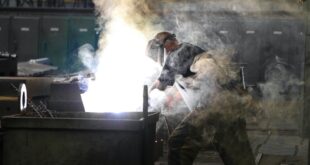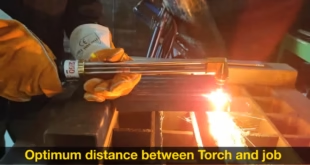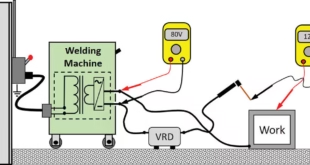Regulations and Standards
Occupational Safety and Health Administration (OSHA) Regulations Regarding Ventilation in Welding Operations
Occupational Safety and Health Administration (OSHA) is the primary regulatory agency responsible for ensuring workplace safety and health in the United States. OSHA has established regulations and standards aimed at protecting workers from exposure to hazardous substances, including welding fumes and gases. Some key OSHA regulations relevant to ventilation in welding operations include:
- General Duty Clause (Section 5(a)(1)): OSHA’s General Duty Clause requires employers to provide a safe and healthful workplace for their employees, which includes implementing adequate ventilation systems to control exposure to welding fumes and gases.
- Permissible Exposure Limits (PELs): OSHA has established permissible exposure limits (PELs) for various substances, including some metals found in welding fumes. Employers must ensure that workers’ exposure to these substances does not exceed the specified PELs over a designated time period.
- Ventilation Requirements (29 CFR 1910.252): OSHA’s welding, cutting, and brazing standard (29 CFR 1910.252) includes requirements for ventilation in welding operations. It specifies that adequate ventilation must be provided to maintain welding fumes and gases below specified exposure limits, and it outlines various methods of achieving this, such as local exhaust ventilation (LEV) systems and general dilution ventilation.
American Welding Society (AWS) Guidelines for Proper Ventilation
The American Welding Society (AWS) is a nonprofit organization dedicated to advancing the science, technology, and application of welding and allied joining processes. AWS provides guidelines and recommendations for proper ventilation in welding environments through various publications and standards. Some key AWS resources related to ventilation include:
- AWS Fume Control Guidelines: AWS offers guidelines for controlling welding fumes and gases in its publication AWS Fume Control Guidelines (ANSI/AWS F1.2/F1.2M:2012). These guidelines provide recommendations for evaluating exposure levels, selecting appropriate ventilation methods, and implementing control measures to minimize exposure to welding fumes.
- AWS Safety and Health Fact Sheets: AWS publishes safety and health fact sheets that provide practical information and recommendations for addressing specific safety concerns in welding operations, including ventilation. These fact sheets cover topics such as ventilation system design, maintenance, and best practices for controlling exposure to welding fumes and gases.
Local Regulations and Standards
In addition to federal regulations such as those enforced by OSHA and guidelines provided by organizations like AWS, employers must also comply with any relevant local regulations and standards governing ventilation in welding operations. These regulations may vary depending on the jurisdiction and may include requirements related to ventilation system design, installation, operation, and maintenance. It is essential for employers to familiarize themselves with applicable local regulations and standards to ensure compliance and protect the health and safety of workers.
Factors Affecting Ventilation Requirements
Type of Welding Process (e.g., MIG, TIG, Stick)
The type of welding process being used has a significant impact on the generation and dispersion of welding fumes and gases. Different welding processes produce varying amounts and types of fumes, which can influence ventilation requirements. For example:
- Shielded Metal Arc Welding (SMAW or Stick): Stick welding typically produces higher levels of welding fumes compared to other processes due to the flux coating on the electrode. Therefore, adequate ventilation is essential to control exposure to these fumes.
- Gas Metal Arc Welding (GMAW or MIG): MIG welding generates a mixture of metal fumes and shielding gas vapors. The composition and quantity of fumes produced depend on factors such as the type of electrode, base metal, and shielding gas used.
- Gas Tungsten Arc Welding (GTAW or TIG): TIG welding generally produces lower levels of fumes compared to other processes, but ventilation may still be necessary to remove any fumes generated and maintain a safe working environment.
Material Being Welded
The material being welded can also influence ventilation requirements. Different metals and materials produce varying levels of hazardous fumes when subjected to welding heat. For example:
- Stainless Steel: Welding stainless steel can produce chromium and nickel fumes, which are known respiratory hazards. Adequate ventilation is necessary to control exposure to these metals.
- Galvanized Steel: Welding galvanized steel releases zinc oxide fumes, which can cause symptoms of metal fume fever and other health effects if inhaled. Effective ventilation is essential to minimize exposure to zinc fumes.
Size and Layout of the Workspace
The size and layout of the workspace where welding operations take place can impact ventilation requirements. Factors such as the dimensions of the space, the presence of barriers or obstructions, and the proximity of workers to the welding source can affect the dispersion of welding fumes and gases. In larger or more confined spaces, additional ventilation may be needed to ensure proper air circulation and fume extraction.
Frequency and Duration of Welding Operations
The frequency and duration of welding operations also influence ventilation requirements. In facilities where welding is performed regularly or for extended periods, continuous ventilation may be necessary to maintain safe air quality and protect workers from harmful fumes and gases. Conversely, in intermittent or occasional welding tasks, temporary ventilation measures may suffice, but still must be implemented to ensure worker safety during welding activities.
Types of Ventilation Systems
Local Exhaust Ventilation (LEV)
Local exhaust ventilation (LEV) systems are designed to capture and remove contaminants at the source, preventing them from spreading into the surrounding environment. These systems are particularly effective for controlling exposure to welding fumes and gases, as they directly extract pollutants generated during welding operations.
Fume Extraction Arms:
- Fume extraction arms consist of flexible ducting with a capture hood at one end, which is positioned close to the welding arc to capture fumes and gases directly at the source.
- The captured contaminants are then conveyed through the ducting to a central filtration or exhaust system, where they are removed from the air before being discharged safely outside or recirculated into the workspace.
Fume Extraction Tables:
- Fume extraction tables are specialized workstations equipped with built-in exhaust systems designed to capture welding fumes and gases generated during welding processes.
- These tables feature perforated surfaces through which contaminants are drawn downward into an integrated ventilation system, minimizing exposure to welders and others in the vicinity.
General Ventilation
General ventilation systems are designed to provide overall air circulation and dilution of contaminants within a workspace, rather than targeting specific sources of pollution. While not as effective as local exhaust ventilation for controlling exposure to welding fumes and gases, general ventilation systems can still help improve air quality and reduce the concentration of pollutants in the environment.
- Natural Ventilation:
- Natural ventilation relies on passive airflow mechanisms, such as windows, doors, vents, and roof openings, to facilitate the exchange of indoor and outdoor air.
- In welding environments, natural ventilation may be used to supplement other ventilation systems or provide airflow in outdoor or well-ventilated indoor spaces where welding operations take place.
- Mechanical Ventilation:
- Mechanical ventilation systems use fans, blowers, and ductwork to actively circulate and ventilate air within a workspace.
- In welding applications, mechanical ventilation systems may include exhaust fans or ventilation hoods positioned strategically to remove welding fumes and gases from the air and exhaust them to the outside or through filtration systems.
- These systems can be tailored to the specific requirements of the welding operation, providing controlled airflow and efficient removal of contaminants to maintain safe working conditions.
Designing an Effective Ventilation System
Identifying Ventilation Needs Based on Welding Processes and Materials
Before designing a ventilation system, it’s crucial to assess the specific ventilation requirements based on the welding processes and materials used in the operation. Considerations include:
- Type of Welding Process: Different welding processes generate varying amounts and types of fumes and gases. Evaluate the characteristics of each process, such as the type of electrode, welding position, and shielding gases used, to determine the potential hazards and ventilation needs.
- Materials Being Welded: Identify the composition of the base metal and any coatings, surface treatments, or contaminants present, as these factors can influence the types and levels of hazardous fumes produced during welding.
- Quantity and Frequency of Welding: Assess the volume and frequency of welding operations to determine the ventilation requirements for effectively controlling exposure to welding fumes and gases in the workspace.
Calculating Air Exchange Rates and Capture Velocities
Once the ventilation needs have been identified, it’s essential to calculate the appropriate air exchange rates and capture velocities to ensure effective contaminant removal. Consider the following factors:
- Air Exchange Rates: Determine the required rate of airflow to achieve adequate ventilation and maintain acceptable air quality in the workspace. Calculate the air exchange rate based on factors such as the size of the workspace, the level of contamination, and regulatory requirements for air quality standards.
- Capture Velocities: Determine the velocity at which contaminants must be captured and removed from the air to prevent their dispersion into the surrounding environment. Calculate capture velocities based on the characteristics of the welding process, such as the size and location of the welding arc, to ensure efficient containment of welding fumes and gases.
Selecting Appropriate Ventilation Equipment
Selecting the appropriate ventilation equipment is critical to the effectiveness of the ventilation system. Consider the following factors when choosing ventilation equipment:
- Local Exhaust vs. General Ventilation: Determine whether local exhaust ventilation (LEV) systems or general ventilation systems are more suitable based on the specific needs of the welding operation and the layout of the workspace.
- Type of Ventilation Equipment: Select ventilation equipment such as fume extraction arms, hoods, exhaust fans, filtration units, or ventilation tables based on factors such as the type of welding process, the size of the workspace, and the ventilation requirements identified during the assessment.
- Compatibility with Welding Equipment: Ensure that the selected ventilation equipment is compatible with the welding equipment and processes used in the operation to facilitate effective containment and removal of welding fumes and gases.
Installation and Maintenance Considerations
Proper installation and maintenance of the ventilation system are essential to ensure its continued effectiveness and compliance with regulatory requirements. Consider the following:
- Proper Placement: Install ventilation equipment in strategic locations to capture contaminants at the source and prevent their dispersion into the workspace. Position fume extraction arms, hoods, and exhaust fans to effectively capture welding fumes and gases generated during welding operations.
- Regular Maintenance: Implement a regular maintenance schedule to inspect, clean, and maintain ventilation equipment to ensure optimal performance and reliability. Replace filters, clean ductwork, and conduct airflow measurements as needed to prevent buildup of contaminants and maintain proper ventilation effectiveness.
- Employee Training: Provide training to employees on the proper use and maintenance of ventilation equipment, as well as safety procedures for working in ventilated areas. Educate workers on the importance of ventilation for controlling exposure to welding fumes and gases and encourage adherence to ventilation protocols for a safe working environment.
Best Practices for Ventilation in Welding Environments
Positioning of Ventilation Equipment Relative to the Welding Operation
Proper positioning of ventilation equipment is critical for effective containment and removal of welding fumes and gases. Consider the following best practices:
- Capture at the Source: Position local exhaust ventilation (LEV) equipment, such as fume extraction arms or hoods, as close to the welding arc as possible to capture contaminants at the source before they disperse into the workspace.
- Optimal Placement: Place ventilation equipment strategically to ensure thorough coverage of the welding area and minimize the spread of contaminants. Position exhaust fans, hoods, and extraction arms to direct airflow away from workers and toward the source of welding fumes and gases.
- Adjustable Equipment: Use adjustable ventilation equipment to accommodate different welding processes, positions, and workpieces. Ensure that ventilation hoods and extraction arms can be easily positioned and maneuvered to capture contaminants effectively during welding operations.
Proper Maintenance of Ventilation Systems
Regular maintenance of ventilation systems is essential to ensure optimal performance and longevity. Follow these best practices for maintaining ventilation systems:
- Scheduled Inspections: Implement a regular inspection schedule to check ventilation equipment for signs of damage, wear, or malfunction. Inspect ductwork, filters, fans, and exhaust systems to identify any issues that may affect ventilation effectiveness.
- Filter Replacement: Replace filters regularly to prevent buildup of contaminants and maintain proper airflow and filtration efficiency. Follow manufacturer recommendations for filter replacement intervals and use high-quality filters designed for capturing welding fumes and gases.
- Cleaning and Lubrication: Clean ventilation equipment, ductwork, and exhaust systems regularly to remove accumulated dirt, debris, and grease. Lubricate moving parts as needed to ensure smooth operation and minimize wear and tear on ventilation components.
- Airflow Calibration: Periodically calibrate airflow measurements and adjust ventilation systems as needed to maintain optimal airflow rates and capture velocities. Conduct airflow tests to ensure that ventilation equipment is effectively removing contaminants from the air and maintaining safe air quality levels.
Training Employees on Ventilation Procedures and Safety Measures
Proper training of employees is essential for ensuring the safe and effective use of ventilation systems in welding environments. Consider the following training best practices:
- Ventilation Awareness: Educate employees about the importance of ventilation for controlling exposure to welding fumes and gases and minimizing health risks associated with welding operations. Emphasize the role of ventilation in maintaining a safe working environment and protecting worker health.
- Operating Procedures: Provide training on proper operating procedures for ventilation equipment, including how to start, stop, and adjust ventilation systems as needed during welding operations. Train employees on the correct positioning of ventilation hoods, extraction arms, and exhaust fans to maximize containment of welding fumes and gases.
- Safety Measures: Educate workers on safety measures for working in ventilated areas, including the use of personal protective equipment (PPE) such as respirators, goggles, and gloves. Reinforce the importance of following ventilation protocols and safety guidelines to minimize exposure to hazardous contaminants and prevent respiratory illnesses and other health effects.
Case Studies and Examples
Successful Implementation of Ventilation Systems in Different Welding Environments
- Manufacturing Facility:
- In a large manufacturing facility with multiple welding stations, a comprehensive ventilation system was installed to control exposure to welding fumes and gases. Local exhaust ventilation (LEV) equipment, including fume extraction arms and hoods, was strategically positioned at each welding station to capture contaminants at the source.
- The ventilation system was designed to provide sufficient airflow and capture velocities to effectively remove welding fumes and gases from the air. Regular maintenance and filter replacement ensured optimal performance of the ventilation equipment.
- As a result of the successful implementation of the ventilation system, air quality in the facility improved, and workers reported fewer respiratory symptoms and health issues associated with welding operations.
- Small Welding Shop:
- In a small welding shop with limited space, a portable fume extraction unit was used to provide localized ventilation at individual welding workstations. The unit featured a flexible extraction arm and integrated filtration system, allowing it to be easily positioned and adjusted as needed.
- Despite the shop’s confined layout, the portable fume extraction unit effectively captured welding fumes and gases, providing adequate ventilation for workers while minimizing the spread of contaminants in the workspace.
- The successful implementation of the portable ventilation unit helped improve air quality in the welding shop and create a safer working environment for welders.
Challenges Faced and Solutions Adopted
- Limited Space:
- Challenge: In tight or confined spaces, it can be challenging to install traditional ventilation equipment due to space constraints and obstruction of airflow.
- Solution: Use portable or flexible ventilation solutions, such as fume extraction arms or portable filtration units, that can be easily positioned and adjusted to provide localized ventilation in cramped workspaces.
- High Ceiling Heights:
- Challenge: Welding operations conducted in facilities with high ceiling heights may experience difficulty in effectively capturing welding fumes and gases due to the upward dispersion of contaminants.
- Solution: Install ceiling-mounted fume extraction systems or exhaust fans with adjustable ductwork to reach elevated welding areas and maintain proper capture velocities. Supplemental airflow may also be necessary to ensure adequate containment of contaminants in high-ceiling environments.
- Variability in Welding Processes:
- Challenge: Different welding processes and materials may require varying ventilation approaches to effectively control exposure to welding fumes and gases.
- Solution: Conduct a thorough assessment of ventilation needs based on the specific characteristics of each welding process and material. Implement a combination of local exhaust and general ventilation systems tailored to the requirements of different welding operations, materials, and workstations.
- Cost Constraints:
- Challenge: Budget limitations may restrict the implementation of comprehensive ventilation systems or the purchase of specialized ventilation equipment.
- Solution: Prioritize ventilation investments based on the level of risk and exposure in welding operations. Explore cost-effective ventilation solutions, such as portable or modular systems, that provide effective containment of welding fumes and gases while minimizing upfront costs.
FAQs
How do welding fumes affect health?
Welding fumes contain various harmful substances that can lead to respiratory problems, neurological disorders, and even cancer with prolonged exposure.
What are some common types of ventilation systems used in welding?
Local exhaust ventilation (LEV) systems, fume extractors, and general ventilation systems are commonly used to control welding fumes.
Are there specific regulations governing welding ventilation?
Yes, organizations like OSHA and ANSI/AWS have established regulations and standards to ensure proper ventilation practices in welding operations.
Why is proper equipment maintenance important for ventilation systems?
Proper maintenance ensures that ventilation systems operate effectively, minimizing the risk of exposure to welding fumes.
How can employers promote a culture of safety regarding welding ventilation?
Employers can promote safety by providing comprehensive training, enforcing safety protocols, and fostering a culture of awareness and accountability among workers.
Conclusion
Proper ventilation is indispensable for maintaining a safe and healthy environment in welding operations. By implementing effective ventilation systems, adhering to standards and regulations, and emphasizing best practices, employers can safeguard the well-being of their workforce.

 Welding of Welders All about Welding and Welders
Welding of Welders All about Welding and Welders



